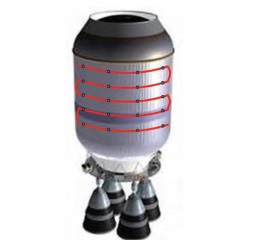Chapter: Fiber Optic Sensing, new invention technology, Research project papers,
Hybrid FOSS (HyFOSS)

Hybrid FOSS (HyFOSS)
The HyFOSS technique employs conventional continuous grating
fibers and then overlays sections every 3 or 4 feet with 'strong' gratings that
can be sampled at higher rates. The new and stronger gratings can be sampled at
rates up to 5,000 hertz (Hz), while the continuous grating sections continue to
be sampled at the lower 100-Hz rate. This technique enables higher spatial
resolution at specific targets without sacrificing resolution in other areas.
The ultimate goal is to achieve sampling rates up to 20 kHz. This increased
sampling capability would allow structural features related to high-frequency
shock and/or vibration to be captured.
Work to date: The team began investigating the technique in
early 2013 after a request from NASA's Kennedy Space Center to
investigate the development effort required to increase the sample rate from
100 Hz to more than 20 kHz. To date, the OFDR technology does not have the
capability to achieve these higher sample rates, though the possibility of
fusing Wavelength Division Multiplexing (WDM) is feasible yet with limited
spatial resolution. Combining the best of OFDR and WDM technologies into new
hardware that utilizes the same optical fiber would allow for high spatial
resolution with lower sample rates in addition to the ability to obtain high
sample rates at strategically spaced points along the fiber.
Looking ahead: Researchers are
investigating a 40-foot fiber strand embedded with the new
technology in the laboratory environment. The Armstrong team also is investigating
the possibilities of pushing the overall sample rate to 20 kHz.
Benefits
More measurements: Offers
higher sampling rates (up to 5 kHz) for specific portions of the fiber
Fast processing: Collects data at
various resolutions without sacrificing speed
Applications
Aeronautics and launch vehicles
Fiber Optic Sensing
Armstrong's portfolio of Fiber Optic Sensing System (FOSS)
technologies offers unparalleled options for high-resolution sensing in
applications that require a unique combination of high-powered processing and
lightweight, flexible, and robust sensors. The system measures real-time
strain, which can be used to determine two-dimensional and three-dimensional
shape, temperature, liquid level, pressure, and loads, alone or in combination.
Initially developed to monitor aircraft structures in flight, the system's
capabilities open up myriad new applications for fiber optics-not just in
aerospace but also for civil structures, transportation, oil and gas, medical,
and many more industries.
The Armstrong approach employs fiber Bragg grating (FBG)
sensors, optical frequency domain reflectometry (OFDR) sensing, and
ultra-efficient algo-rithms (100 samples/second). Engineers are continually
seeking new ways of looking at information and determining what is important.
Armstrong's FOSS technologies focus on critical research needs. Whether it is
used to determine shape, stress, temperature, pressure, strength, operational
load, or liquid level, this technology offers ultra-fast, reliable
measurements.
Related Topics